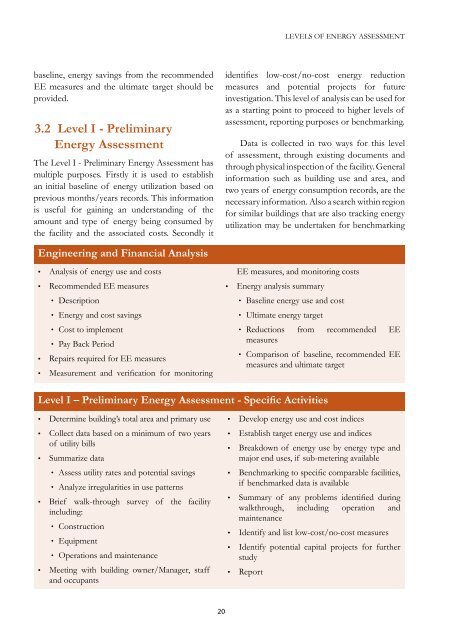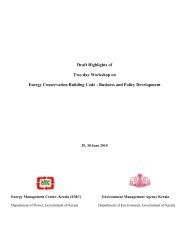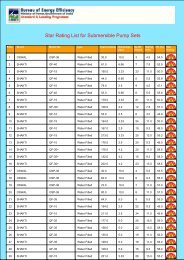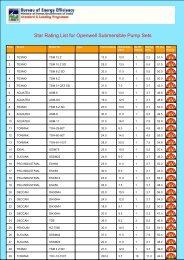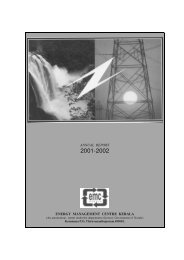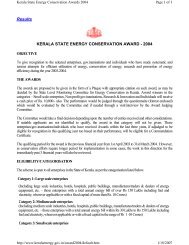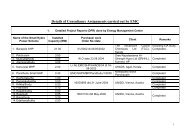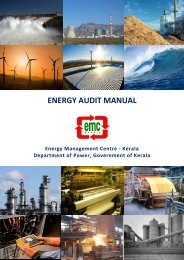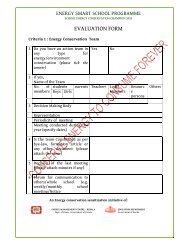energy assessment guide for commercial buildings - ECO-III
energy assessment guide for commercial buildings - ECO-III
energy assessment guide for commercial buildings - ECO-III
Create successful ePaper yourself
Turn your PDF publications into a flip-book with our unique Google optimized e-Paper software.
LEVELS OF ENERGY ASSESSMENT<br />
baseline, <strong>energy</strong> savings from the recommended<br />
EE measures and the ultimate target should be<br />
provided.<br />
3.2 Level I - Preliminary<br />
Energy Assessment<br />
The Level I - Preliminary Energy Assessment has<br />
multiple purposes. Firstly it is used to establish<br />
an initial baseline of <strong>energy</strong> utilization based on<br />
previous months/years records. This in<strong>for</strong>mation<br />
is useful <strong>for</strong> gaining an understanding of the<br />
amount and type of <strong>energy</strong> being consumed by<br />
the facility and the associated costs. Secondly it<br />
identifies low-cost/no-cost <strong>energy</strong> reduction<br />
measures and potential projects <strong>for</strong> future<br />
investigation. This level of analysis can be used <strong>for</strong><br />
as a starting point to proceed to higher levels of<br />
<strong>assessment</strong>, reporting purposes or benchmarking.<br />
Data is collected in two ways <strong>for</strong> this level<br />
of <strong>assessment</strong>, through existing documents and<br />
through physical inspection of the facility. General<br />
in<strong>for</strong>mation such as building use and area, and<br />
two years of <strong>energy</strong> consumption records, are the<br />
necessary in<strong>for</strong>mation. Also a search within region<br />
<strong>for</strong> similar <strong>buildings</strong> that are also tracking <strong>energy</strong><br />
utilization may be undertaken <strong>for</strong> benchmarking<br />
Engineering and Financial Analysis<br />
• Analysis of <strong>energy</strong> use and costs<br />
• Recommended EE measures<br />
•• Description<br />
•• Energy and cost savings<br />
•• Cost to implement<br />
•• Pay Back Period<br />
• Repairs required <strong>for</strong> EE measures<br />
• Measurement and verification <strong>for</strong> monitoring<br />
EE measures, and monitoring costs<br />
• Energy analysis summary<br />
•• Baseline <strong>energy</strong> use and cost<br />
•• Ultimate <strong>energy</strong> target<br />
•• Reductions from recommended EE<br />
measures<br />
•• Comparison of baseline, recommended EE<br />
measures and ultimate target<br />
Level I – Preliminary Energy Assessment - Specific Activities<br />
• Determine building’s total area and primary use<br />
• Collect data based on a minimum of two years<br />
of utility bills<br />
• Summarize data<br />
•• Assess utility rates and potential savings<br />
•• Analyze irregularities in use patterns<br />
• Brief walk-through survey of the facility<br />
including:<br />
•• Construction<br />
•• Equipment<br />
•• Operations and maintenance<br />
• Meeting with building owner/Manager, staff<br />
and occupants<br />
• Develop <strong>energy</strong> use and cost indices<br />
• Establish target <strong>energy</strong> use and indices<br />
• Breakdown of <strong>energy</strong> use by <strong>energy</strong> type and<br />
major end uses, if sub-metering available<br />
• Benchmarking to specific comparable facilities,<br />
if benchmarked data is available<br />
• Summary of any problems identified during<br />
walkthrough, including operation and<br />
maintenance<br />
• Identify and list low-cost/no-cost measures<br />
• Identify potential capital projects <strong>for</strong> further<br />
study<br />
• Report<br />
20


